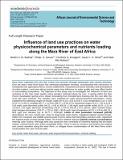| dc.contributor.author | Wafula, Martin S.M. | |
| dc.contributor.author | Owuor, Philip O. | |
| dc.contributor.author | Kengara, Fredrick O. | |
| dc.contributor.author | Ofula, Ayub V. O. | |
| dc.contributor.author | Matano, Said-Ally | |
| dc.date.accessioned | 2018-07-03T22:12:39Z | |
| dc.date.available | 2018-07-03T22:12:39Z | |
| dc.date.issued | 2018-07 | |
| dc.identifier.citation | Wafula, M.S.M.; Owuor, P.O.; Kengara, F.O.; Ofula, A.V.O.; Matano, A.S.. (2018). Influence of some land uses practices on water physicochemical parameters and nutrients loading along the Mara River of East Africa. African Journal of Environmental Science and Technology, 12(7), 235-243 | en_US |
| dc.identifier.issn | DOI: 10.5897/AJEST2015.2021 Article Number: CE338A557624 ISSN: 1996-0786 | |
| dc.identifier.uri | https://repository.maseno.ac.ke/handle/123456789/657 | |
| dc.description.abstract | Mara River originates from the Mau Forest and traverses through landscapes with varying activities. Over the years, Mara River Basin has witnessed population increase, accompanied with conversion of forestlands into agricultural farms, human settlements, industrial and tourist activities and development of urban centres. Land uses along riverine areas have influence on water quality and may affect health of surrounding ecosystems. The objective of this study was to investigate the influence of land use
activities on the river water quality using samples collected along the river. A spring within the Mau Forest (Ainabsabet spring) and a stream emanating from forested land draining into the river after the mine site were controls. The samples were analyzed for water physicochemical parameters, which registered the following ranges of results; water pH (5.23 ± 0.01 to 8.04 ± 0.01), temperature (11.5 ± 0.06 to 23.73 ± 0.06°C), turbidity (65.77 ± 21.58 to 369.47 ± 15.69 NTU), dissolved oxygen (6.14 ± 1.55 to 8.18 ± 0.03 mg/l), total dissolved solids (45.22 ± 0.65 to 308.33 ± 2.08 mg/l), total soluble solids (6.33 ± 2.31 to
110.56 ± 1.50 mg/l), electrical conductivity (34.32 ± 0.45 to 252.00 ± 5.57 μS/cm), water nutrient loads; total nitrogen derivatives (223.57 ± 2.22 to 1630 ± 96.56 μg/l), total phosphates (42.32 ± 0.34 to 681.23 ± 68.8 μg/l) and silicates (up to 65.77 ± 0.65mg/l). Levels of most parameters increased (p≤0.05) downstream the river. Emarti site, close to large-scale maize farms, registered highest nutrient levels. Water from livestock and wildlife grazing areas (Tarime sites) that had gullies and bare soils, registered the highest levels of total soluble solids. The Kirumi wetland reduced (p≤0.05) nutrients oncentrations
entering Lake Victoria. Although land uses along the river contribute to nutrients loading into the water system, nutrient levels were within acceptable limits. There is need to conserve and protect the wetland and control activities along the Mara River, to mitigate future contamination of the Mara River which would pollute the Lake Victoria water. | en_US |
| dc.description.sponsorship | Lake Victoria Basin Commission | en_US |
| dc.publisher | AcademicJournal, African Journal of Environmental Science and Technology | en_US |
| dc.subject | Mara River basin, land use, water physicochemical parameters, nutrients loading | en_US |
| dc.title | Influence of land use practices on water physicochemical parameters and nutrients loading along the Mara River of East Africa | en_US |
| dc.type | Article | en_US |

